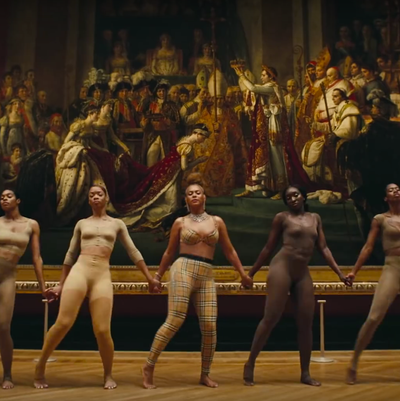
Go to the corner and think about what you’ve done, Musée d’Orsay. Beyoncé and Jay-Z, ever the ones to anticipate your summer sonic needs, dropped a surprise joint album Everything Is Love last night, pairing a stunning visual element with the track “Apeshit.” But they’re not here just to drop some killer lines and don pastel suits around metropolitan Paris. (A taste: “Tell the Grammy’s fuck that 0 for 8 shit / Have you ever seen the crowd goin’ apeshit?”) For the Carters were granted private access to the Louvre, where they gallivanted all around the famed museum to our awe. Since this is the holy goddamn Louvre after all, allow Vulture to give you a brief art history lesson for the most prominent works featured in the music video. Consider it Art History 201, without that weird sexual tension with your professor.
“Mona Lisa”
Yeah, you might’ve heard of this one. It was painted by Leonardo da Vinci during the Renaissance period in 1503. (But who actually is the Mona Lisa?) Next.
“The Coronation of Napoleon”
This gigantic masterpiece was completed by Napoleon’s official painter, Jacques-Louis David, in 1807. Bey and Jay, seemingly, really admire David’s virtuoso neoclassical style. Two other David paintings can also be seen in brief, fleeting moments in the video — “Oath of the Horatii” (1784) and “The Intervention of the Sabine Women” (1799).
“Portrait of Madame Récamier”
And we have yet another David! It’s a big day for him! This was painted in 1800 for Juliette Récamier, who was one of the most famous socialites in Paris at the time. She was the wife of a banker.
“The Winged Victory of Samothrace”
Like David’s work, this Hellenistic marble sculpture — the artist is unknown — is a focal point throughout the video. (It’s commonly dated to 2nd century BC.) It was sculpted to honor Nike, the Greek goddess of victory. Just look at those wings.
“Great Sphinx of Tanis”
The Louvre houses one of the most impressive collections of Egyptian artwork outside of Africa, and this sphinx — made from granite, likely around 2600 BCE in the Old Kingdom — is the largest in the museum. It has a body of a lion and a head of a king.
“Venus de Milo”
Not even the mutilated arms have prevented the sculpture from becoming one of the most defining works of ancient Greece. (It’s dated around 100 BCE.) It’s believed to have been sculpted to the likeness of Aphrodite, the Greek goddess of love and beauty.
“The Raft of the Medusa”
Théodore Géricault’s pièce de résistance in romanticism was completed in 1819, and based on actual, horrible events — more than 150 French soldiers were left to fight for their lives off the coast of Senegal years prior due to a ship wreck. Only a few survived. You can also see a close-up of another Géricault painting, “The Charging Chasseur,” in a separate frame earlier in the video.
“Louvre Pyramid”
We! Respect! Modern architecture! Even the Carters can’t resist grooving around the museum’s glass-metal landmark, which was designed by I.M. Pei and completed in 1989.


